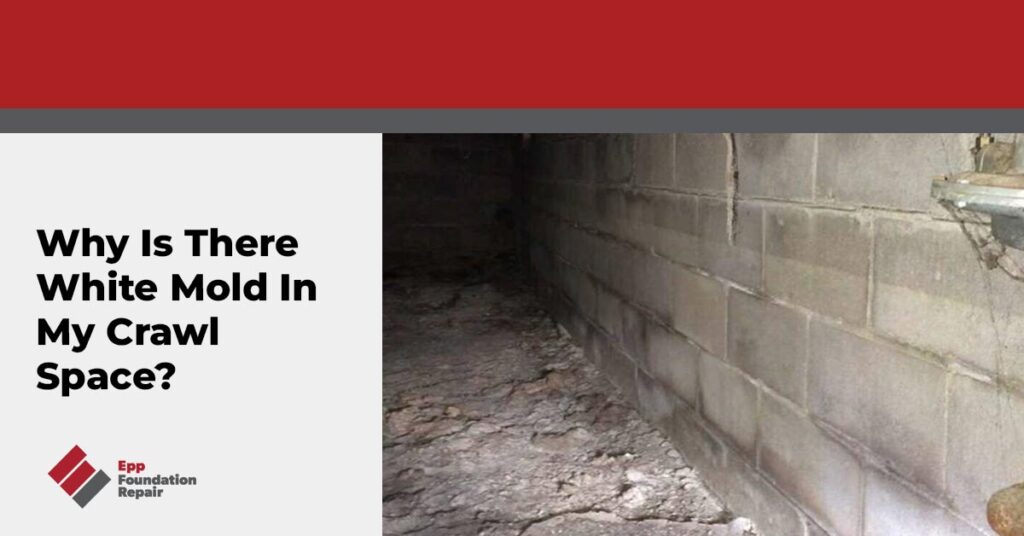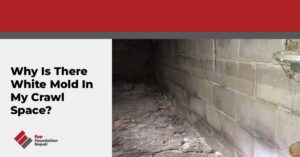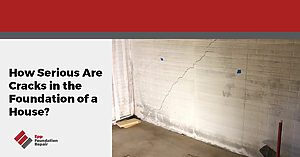If you’re searching for information about white mold in a crawl space, you’ve landed on the right page. In this article, we’re going to talk about the causes of white mold in a crawl space, why crawl spaces get wet, the possible danger from white mold, and more.
What Is White Mold?
White mold is a common type of mold. It might be aspergillus, penicillium, or another type of white mold. Don’t get hung up on the kind of mold in your home’s crawl space. All mold in a crawl space is bad.
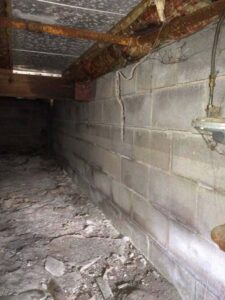
Are You Sure It’s White Mold? It Might Be Efflorescence.
Efflorescence happens when dissolved salts in water rise to the concrete’s surface. Efflorescence is white and can be mistaken for white mold. Efflorescence isn’t harmful itself. However, it does indicate the presence of moisture, something you don’t want in a crawl space.
What Causes White Mold In A Crawl Space?
White mold in a crawl space – actually, all mold in a crawl space – is caused by moisture in the crawl space. So, where does the moisture come from? Moisture in a crawl space can come from various sources including:
- Leaky plumbing – Plumbing leaks are a common source of crawl space moisture.
- High groundwater level – A high groundwater level can cause the dirt floor of the crawl space to be wetter than normal. This contributes to moisture in the crawl space.
- Open crawl space vents – Open vents allow warm, humid air to enter and condense on cooler surfaces, creating moisture.
- Poor drainage around the foundation – Poor drainage around the foundation is probably the most common cause of crawl space moisture. Fortunately, poor drainage can be fixed via a drain tile system. For more information about how a drain tile system works see, How Does A Drain Tile System Work?
Is White Mold In A Crawl Space Dangerous?
You don’t want any mold in a crawl space because a percentage of crawl space air flows up into your home’s living space via the stack effect. Therefore, you don’t want a crawl space full of mold spores because it could cause allergies and other respiratory problems for anyone living in the home.
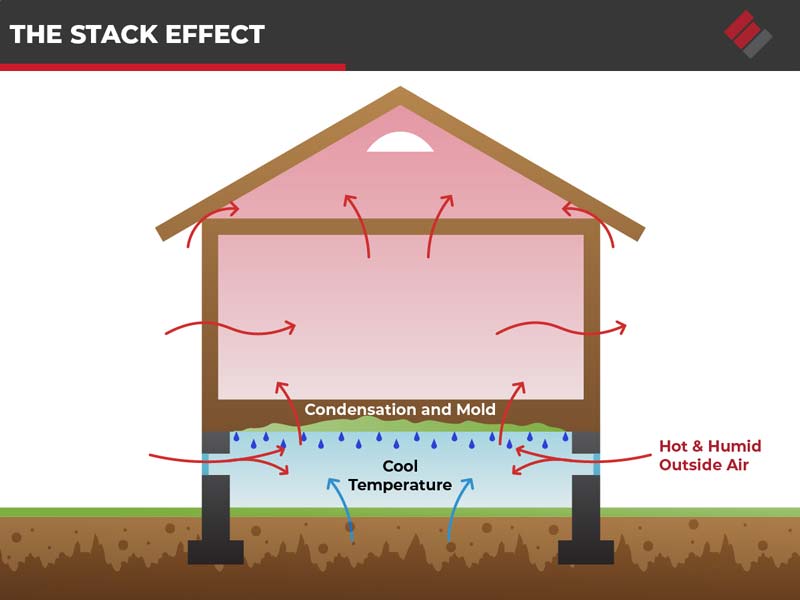
How To Get Rid Of Existing White Mold In A Crawl Space
We don’t recommend homeowners enter the crawl space under their house. If there’s existing white mold in your crawl space, contact a professional and ask them to get rid of it. Never enter your crawl space without wearing protective gear, including a respirator.
How To Prevent White Mold From Growing In A Crawl Space
You can prevent any type of mold, including white mold, from growing in a crawl space by keeping moisture down in the crawl space. Here are a few ways to do that:
- Don’t plant flowers, shrubs, trees, etc., next to the house. When you water them, you’ll be adding moisture to the soil around the foundation. You’re trying to avoid this.
- Clean your gutters on a regular basis so that water doesn’t spill over the side of the house and soak the ground around the foundation.
- If necessary, install downspout extensions so that runoff is carried at least four feet away from the foundation before being released.
- Install an underground downspout along with a pop-up emitter. Runoff flows into the underground downspout and toward the pop-up emitter situated somewhere in your yard about 10 feet from the foundation. Once the pop-up emitter is full, it pops up and ejects the water away from the foundation. (When the pop-up emitter is empty, it sits flush with the ground and is barely visible.)
- Install a drain tile system. A drain tile system keeps excess moisture from building up in the soil around the foundation. We’ll talk more about drain tile systems in just a bit.
- Encapsulate the crawl space. Crawl space encapsulation can turn your crawl space into an area that’s clean and dry enough to use for storing things like tools and holiday decorations. We’ll talk more about crawl space encapsulation in the next section.
- Make sure you don’t have any plumbing leaks in the crawl space.
Notice that most of the things listed above have to do with getting groundwater around the foundation under control. This is key, if you want a dry, mold-free crawl space.
The Permanent Cure For White Mold In A Crawl Space: A Drain Tile System Plus Crawl Space Encapsulation
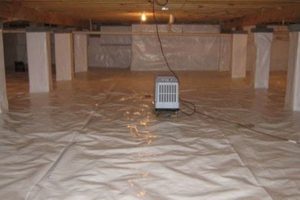
A drain tile system along with crawl space encapsulation and a dehumidifier is the way to go, If you want a clean, dry, mold-free crawl space.
Drain Tile System
When it comes to crawl space waterproofing, nothing beats a drain tile system. A drain tile system helps keep your home’s crawl space dry by preventing excess moisture from building up in the soil around the foundation.
There are two types of drain tile systems, exterior and interior. Both can be installed in existing homes.
Exterior drain tile systems
An exterior drain tile system is installed around the outside perimeter of the foundation at the footing level. The general installation procedure is as follows:
- The soil around the foundation is excavated down to the footing.
- A shallow trench is dug around the perimeter of the foundation and filled with gravel.
- A perforated drainage pipe is placed into the trench and covered with more gravel.
- The excavated soil is replaced.
Excess moisture in the soil will now flow into the drainage pipe and get channeled toward a sump pit. When the sump pit fills with water, a sump pump will kick in and release the water away from the foundation.
Interior drain tile systems
An interior drain tile system is installed around the inside perimeter of the crawl space. The installation is similar to that of the exterior drain tile system:
- A shallow trench is dug around the inside perimeter of the crawl space and then lined with gravel.
- A perforated drainage pipe is placed into the trench and covered with more gravel.
Any excess moisture in the soil will now find its way into the perforated drainage pipe and get channeled toward the sump pit. Once the water in the sump pit reaches a certain level, the sump pump will turn on and expel the water away from the foundation.
Crawl Space Encapsulation
Crawl space encapsulation involves sealing the vents and covering the floor and walls of the crawl space with a thick, plastic vapor retarding barrier. This seals the floor off from the rest of the crawl space.
In addition to crawl space encapsulation, we recommend installing a dehumidifier as well. This ensures that the humidity level in crawl space stays low. As we mentioned above, an encapsulated crawl space is clean, dry, and can be used for storing things like tools and holiday decorations.
For more information about crawl space encapsulation see, Is Crawl Space Encapsulation Worth It? Yes!
Crawl Space Dehumidifier
After the crawl space is encapsulated, a crawl space dehumidifier is added to ensure that the humidity level in the crawl space stays low.
If you’re concerned about white mold in your crawl space, contact us today for a crawl space evaluation. We serve areas in Nebraska, Iowa, Kansas, and Missouri. See our Service Areas page for more information.

